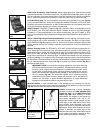
Polar Alignment
The great majority of ETX-60AT and ETX-70AT
owners will find it unnecessary ever to Polar align
the telescope. With these ETX telescope models
the standard-equipment Autostar controller allows
the telescope to be used in the altazimuth (Alt/Az)
orientation for all observing purpose. This section
is included only for educational purposes, where
the observer might wish to operate the analog set-
ting circles
(13 and 17, Fig.1) in place of the digi-
tal setting circles built into the Autostar hand con-
troller. Absent a desire to use the analog circles or
simply to be informed about the use of the equato-
rial (Polar-aligned) mount, reading of this appendix
may be omitted.
In Polar Alignment, the telescope is oriented so that the horizontal and vertical axes of the tele-
scope are lined up with the celestial coordinate system. Polar Alignment requires the telescope
to be mounted to the optional #883 Deluxe Field Tripod
(Fig. 26)
.
In order to Polar align your telescope, it is essential to have an understanding of how and where
to locate celestial objects as they move across the sky. This section provides a basic introduc-
tion to the terminology of Polar-aligned astronomy, and includes instructions for finding the
celestial pole and for finding objects in the night sky using Declination and Right Ascension.
Celestial Coordinates
Celestial objects are mapped according to a coordinate system on the Celestial Sphere (Fig. 26),
an imaginary sphere surrounding Earth on which all stars appear to be placed. This celestial object
mapping system is analogous to the Earth-based coordinate system of latitude and longitude.
The poles of the celestial coordinate system are defined as those two points where the Earth’s
rotational axis, if extended to infinity, North and South, intersect the celestial sphere. Thus, the
North Celestial Pole (1, Fig. 27) is that point in the sky where an extension of the Earth’s axis
through the North Pole intersects the celestial sphere. This point in the sky is located near the
North Star, Polaris.
In mapping the surface of the Earth, lines of longitude are drawn between the North and South
Poles. Similarly, lines of latitude are drawn in an East-West direction, parallel to the Earth’s
Equator. The Celestial Equator (
2, Fig. 27) is a projection of the Earth’s Equator onto the celes-
tial sphere.
Just as on the surface of the Earth, in mapping the celestial sphere, imaginary lines have been
drawn to form a coordinate grid. Thus, object positions on the Earth’s surface are specified by
their latitude and longitude. For example, you could locate Los Angeles, California, by its lati-
tude (+34°) and longitude (118° West); similarly, you could locate the constellation Ursa Major
(which includes the Big Dipper) by its general position on the celestial sphere:
R.A.: 11hr; Dec: +50°.
•
Right Ascension: The celestial analog to Earth longitude is called “Right Ascension,” or
“R.A.,” and is measured in time on the 24 hour “clock” and shown in hours or “hr," minutes
or “min," and seconds or “sec," from an arbitrarily defined “zero” line of Right Ascension
passing through the constellation Pegasus. Right Ascension coordinates range from 0hr
0min 0sec to 23hr 59min 59sec. Thus there are 24 primary lines of R.A., located at 15
degree intervals along the celestial equator. Objects located further and further East of the
prime Right Ascension grid line, 0hr 0min 0sec, carry increasing R.A. coordinates.
•
Declination: The celestial analog to Earth latitude is called Declination, or “Dec,” and is
measured in degrees, arc-minutes and arc-seconds, e.g., 15° 27' 33". Declination shown
as North of the celestial equator is indicated with a “+” sign in front of the measurement,
14
15
16
17
18
19
20
21
22
23
0
1
12
11
10
9
8
7
5
6
4
3
2
13
Earth’s
Rotation
0 Dec.
South
Celestial
Pole
Right Ascension
Star
Celestial
Equator
-90 Dec.
+90 Dec.
North
Celestial
Pole
(Vicinity
of Polaris)
D
e
c
l
i
n
a
t
i
o
n
1
2
Fig. 27: Celestial Sphere.
Fig. 26:
Tripod set in Polar
configuration
on optional
#883 tripod.
APPENDIX A: EQUATORIAL (POLAR) ALIGNMENT
Appendix A 31


















